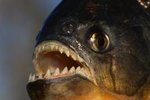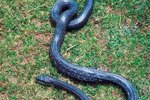
The cottonmouth (Agkistrodon piscivorus) is a semiaquatic snake of the genus Agkistrodon. These venomous reptiles also often are known by the name "water moccasin." Cottonmouths are large, hefty snakes that usually are deep brown or black in coloration. Their moniker is derived from one of their protective mechanisms, which is opening their jaws up wide to reveal stark white oral chambers.
Cottonmouth Background Information
These carnivorous creatures feast predominantly on fish, other reptiles and mammals. These ambush predators are rather opportunistic in their feeding habits, and also will handily consume frogs, birds, turtles, carrion and bugs. Cottonmouths lead solitary lifestyles and do not tend to stray much from whatever specific environment they make their homes. Some of these snakes' common predators include human beings, hawks, dogs, raccoons, snapping turtles and cats. The cottonmouth snake with the longest verified lifespan survived to almost 25 years old, according to Animal Diversity Web of the University of Michigan.
Where Cottonmouths Live
Cottonmouth snakes are residents of the United States alone. They are prevalent especially in the southeastern region of the nation. The geographic scope of these reptiles includes Tennessee, South Carolina, North Carolina, Kentucky, Alabama, Texas, Virginia, Louisiana, Florida, Arkansas and Mississippi. Outside of the south, cottonmouths also occur in Indiana, Illinois, Kansas and Missouri. Some of these reptiles also inhabit offshore locales.
Habitat of Cottonmouths
These terrestrial snakes live in an array of different environments, with wetlands usually being their habitat of choice. Although they are drawn to wet settings, cottonmouths also frequently live on dry land below logs and in the midst of dense plant life. Cottonmouths usually are not far from water, however. Other typical locations for cottonmouths are cypress swamps, creeks, dams, river floors, lakes, salt marshes, streams, floodplains for rivers, sloughs, bayheads and bayous.
Hibernation Locations
Not all cottonmouths hibernate during the winter months, but those that reside in northern climates generally do. Hibernating cottonmouths generally retreat to rugged hillsides, spots below decaying tree stumps or burrows established previously by other creatures, such as tortoises, muskrats or beavers.
References
Photo Credits
-
Jupiterimages/Brand X Pictures/Getty Images




